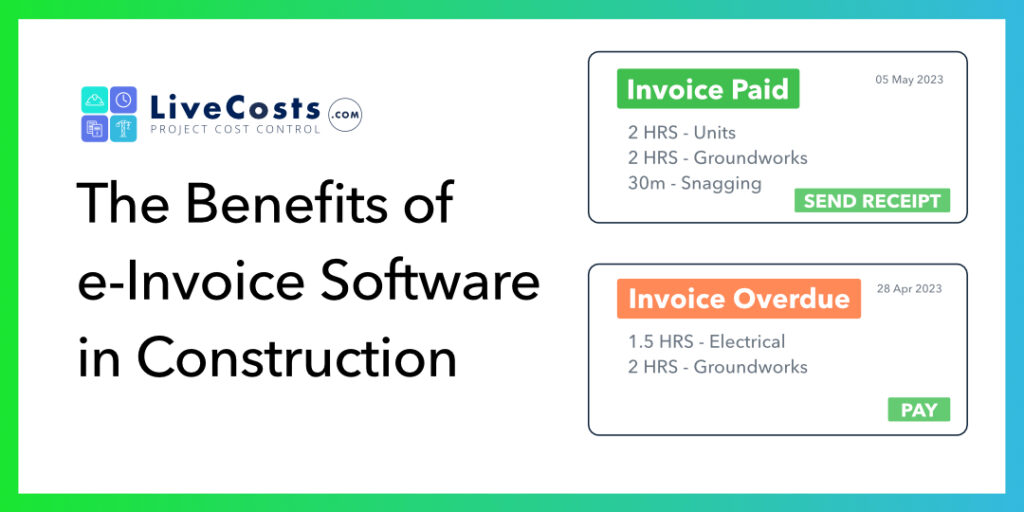Why Switch from Manual Invoice Processing?
A better question might be: why are you still processing your invoices manually?
Thousands of construction companies have made the big switch from a manual invoicing process to a digital one, and it’s always for the same reasons: electronic invoicing is faster, more secure, and it saves your company money.
These are the most typical reasons construction companies move away from manual invoicing and embrace digital.
- Errors in matching between invoice, purchase order, and delivery dockets
- Payments get delayed
- Risk of fraud
- Invoices get lost
- Duplicate payments
If any of these sound familiar, it might be time for your construction company to seriously consider making the leap to digital.
But integrating a digital invoicing solution into your accounts workflow is easier said than done.
That’s why we’ve written this guide to help you understand the benefits and challenges of construction invoicing software, and with some advice on how best to implement it.
- How To Know What Features You Need, So You Don’t Overpay
- Benefit 1: Construction Projects Stay On-Budget
- Benefit 2: Reduce Manual Data Entry, Human Error, and Administrative Costs
- Benefit 3: Cloud Storage for e-Invoices
- Benefit 4: Never Overpay A Supplier
- Benefit 5: Improved Communication With Suppliers And Customers
- Benefit 6: Accurate Project Reporting
How To Know What Features You Need, So You Don’t Overpay
Before you up-end your entire company’s accounting process, consider carefully what you truly need from an e-invoice software, and what’s “nice to have”.
Go through your construction company’s current accounting process in every detail, step by step, and write down what you think can be automated. This way you’ll know what you need, and what’s just an expensive upsell on the vendor’s part.
Right away, you’ll see if you need one of the bigger softwares that are designed for construction companies with multiple offices, projects, and sites. The better company-based softwares will automatically reconcile invoices with purchase orders and delivery dockets, in a 3-way match.
Or maybe a simpler invoicing software, designed for contractors and sole traders, is all you need. These e-invoice softwares tend to just handle payments, signatures, and personal tax.
Already you’ve narrowed the options of which software is the best fit for you.
Buyer Beware
There’s no shortage of softwares with features that make a great demo, but then go years in a company without ever being clicked.
You need to know what you need before reaching out to any software’s Sales Team, because the salesperson will try to sell you every feature they think you might buy. They’ll warn you about future-proofing your business, and try to scare you into buying every security upgrade possible.
But if their software isn’t already future-facing, or secure out-of-the-box, why would you buy it?
Don’t fall for software “feature-itis”. Armed with your list of requirements, buy only what you need. Here’s how.
Choosing an e-Invoice Software for Construction
Here are the most important questions to ask any e-invoicing software before signing up:
- How many users in my company will need to use this?
- How many invoices can I create and send every month, or year?
- Does it include electronic signatures?
- If it does, does the person I’m sending an invoice to also need a subscription to sign?
- Does it come with real staff training, or is training just a link to their website?
- Finally, can it automatically reconcile invoices with purchase orders and delivery Dockets?
Take A Tour of LiveCosts Construction Invoice Software
See why thousands of construction projects around the world choose LiveCosts to manage their e-invoices.What Are The Benefits of e-Invoice Software in Construction?
I’ll tell you straight – it’s a long list, and it varies by company. But any construction company still using a combination of Excel, paper, and hope in their accounting process will see immediate benefits from e-invoicing software.
But it’s not without its challenges – we’ll dig into those later. Until then, here are the 6 most common benefits of implementing electronic invoice software into a construction company:
- Projects Stay On-Budget
- Reduce Manual Data Entry, Human Error, and Administrative Costs
- Cloud Storage
- Never Overpay a Supplier
- Improved Communication
- Accurate Project Reporting
Benefit 1: Construction Projects Stay On-Budget
Construction projects still using manual invoice processing go over-budget when:
- discrepancies are caught too late;
- invoices for materials spanning multiple parallel projects are too murky to track accurately;
- and when an invoice’s line items don’t reconcile properly with a purchase order, but nobody can remember what that item was for.
What do all these reasons have in common? Human error.
Didn’t see it. Too difficult to understand. Or just plain can’t remember.
The greatest benefit of any electronic invoicing software to your company isn’t any one cool feature – it’s that it safeguards your construction projects against accidental or unexpected overruns.
When every line of every invoice is requested digitally, approved digitally, and paid digitally, you have at the end of every project a perfect digital paper trail.
Now in every project you’ll know exactly who requested what, in what amount and quantity, what it was for, and if it’s been paid.
Benefit 2: Reduce Manual Data Entry, Human Error, and Administrative Costs
Manual data entry eats up time, makes mistakes, and costs money.
For it to go smoothly, every incoming purchase order has to be correct to begin with, then typed without error into Excel, and later printed and stored in a binder, usually in a room full of identical binders.
How efficient does that sound?
Manual Data Entry Takes Too Long
Let’s start with time. Manual data entry, even before factoring in the time needed to approve each invoice, takes forever – and longer again when an invoice spans multiple departments.
This can mean late payments to suppliers, and with them penalties (“late fees”). You might even miss out on early payment discounts that a lot of suppliers offer construction companies, just to protect their own cash flow.
And it can affect your reputation and relationship with your suppliers. With construction materials in constant short supply, who is your supplier going to prioritise? You, or the guy who paid them on time before?
It’s Full Of Mistakes
Fact: 88% of all Excel files contain at least one human error. Which means that 9 in every 10 of your Excel files probably have a mistake lurking in the rows and columns.
No well-rounded human can enter data for 8 hours a day, every day, without making at least one mistake. This means that, for at least part of your construction project, you’re working off the wrong numbers. And bad data leads to nasty surprises, disputes, and usually some financial loss to the business.
In really bad scenarios, construction companies can find themselves owing outstanding VAT and other taxes – and face fines.
Though it’s just one leg on the stool of the 3-Way Match, a well-oiled electronic invoicing workflow will let you make quotes, order materials, and project profits with accuracy and confidence.
Reduce Administrative Costs
Because manual data entry takes so long, and has mistakes, it often needs to be proofed a second time. That’s more staff, and more paid staff time, spent doing clerical work that can be done much faster and more accurately by software.
A well-implemented electronic invoicing solution into your accounting system could save your construction company a week a month – often more – of staff time, overtime, and seasonal help when facing into your end-of-year tax returns.
Many construction companies also say that it saves them on accountancy fees, because they no longer have to request an update from their accountant to see if their current projects are profitable or not.
Benefit 3: Cloud Storage for e-Invoices
Bad news: It’s tax season.
Worse news: Your entire system is still based on paper.
Now you have to unearth thousands of pieces of paper, spanning multiple projects, suppliers, contractors, and customers, and try to reconcile them coherently enough that you don’t find yourself paying large fines because your tax payments were wrong.
Tax compliance is just one of the benefits of keeping your electronic invoices in cloud storage. In fact, cloud storage has completely revolutionised how construction companies store, manage, and recall their electronic invoices and all the data contained inside them.
With cloud storage your construction company can instantly pull up any invoice, going back years, and see every line item. No faded ink on paper; no smeared signatures.
Cloud Storage Is More Secure
Printed documents can get lost, get wet, or fade over time. Cloud storage gets backed up, so you’ll never be stuck looking for a vital invoice or its details.
That one supplier who stocked that really niche item a few years back? Now you can pull their details up on screen in seconds.
All construction companies should also consider internal security. Sensitive company information has no place being stored in on-display binders, where any member of staff can access it. Why expose yourself to a potential disgruntled employee? Or risk a staff member taking your special trade prices to another company?
Almost every electronic invoice software comes with built-in, password-protected permission sets, so you as the Administrator can decide which staff are allowed to access which invoices.
Benefit 4: Never Overpay A Supplier
Bad news, suppliers of the world. E-Invoicing software means that construction companies are likely to spot any accidental overcharges.
Electronic invoicing is probably the most effective way for your construction company to avoid overpayment. Because everything is part of a digital paper trail, you’ll only pay for the materials or contracted labour provided, and only for the quantity that was ordered.
When you track payments digitally, discrepancies should be caught in real-time – not at the end of a project, when it’s a real pain to go back and dispute and overpayment.
Benefit 5: Improved Communication With Suppliers And Customers
When everybody is happy with the price, and everybody receives what they expected, everyone wins. The construction company, the supplier, and the customer are happy.
The financial upshots for your construction company are repeat business, customer referrals, and even early payment discounts from suppliers who live and die by cash flow.
Electronic invoices are a brilliant arrow in the sling of tools to improve communication between your business and your customers. When you have a digital record of all payments, disputes rarely arise, and when they do they’re settled quickly.
Even better, with some construction companies still lagging behind and using manual invoicing methods, your electronic invoice can ‘wow’ some customers and leave a strong impression on your brand of competence and diligence.
Finally, you’re building trust with your customers and prospects with your transparency. With some companies still offering quotes off the top of their head, your slick line-item invoice will impute certainty and capability.
Benefit 6: Accurate Project Reporting
To be frank: No construction company can have truly accurate live reporting without deploying the 3-Way Match into their accounting workflow – and sticking with it.
But a sound electronic invoice software will certainly go a long way to you having live, accurate reports on your construction projects and their phases.
If you have to wait for paper to arrive or be posted, or to call your accountant for an update, your reporting isn’t ‘live’.
And if your company is relying on Excel and paper, then it’s probably not accurate, either.
That’s a far cry from being able to accurately price construction projects, and project profits.
Here’s where electronic invoicing software can give your construction project reporting a real lift: because it’s digital, it’s instant; and because it’s automatically generated, it’s accurate.
Now you can see, even at the project level, which payments are outstanding, what they were for, and have you received what you paid for – all in one report.



